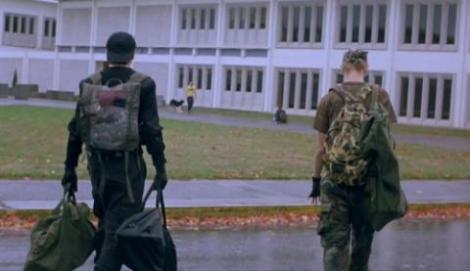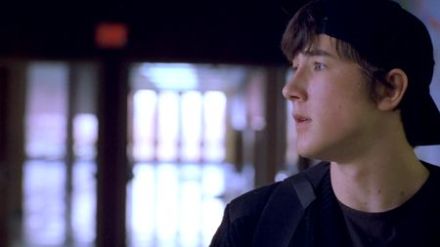Last week a couple of friends and I watched Gus Van Sant’s Elephant (2003) and Lynne Ramsay’s We Need To Talk About Kevin (2011) back to back. It was a heavy night. Not the type of activity I usually consider fun. But it ended up being really interesting to watch the two films side by side, and to see what the two directors did with such loaded (no pun intended) material. How are you supposed to depict a school shooting without sensationalism, melodrama, or just “getting it wrong”? I think both films were pretty successful in doing this, although they did it in extremely different ways.
I always feel a little awkward when I say that Elephant is one of my favorite movies. It’s certainly not a film you want to say you enjoyed. Based loosely on the 1999 Columbine High School massacre, Elephant is about an ordinary high school day that quickly escalates into chaos when two students come to school with guns and explosives. I think for me, the reason this film appealed to me so much was because it was the first “artsy” film that I could really appreciate. Throughout the film, Van Sant uses long tracking shots to follow individual students as they go about their day. There is little scripted dialogue and almost no non-diegetic sound, and the narrative is not presented in chronological order. Van Sant establishes a slow pace at the beginning of the film, and he maintains that pace until the end—so the same slow tracking shots that follow the students as they go to class are then used to follow the two boys as they gun down their classmates. I found this style of filming alienating at first, but eventually I came to really appreciate it. Instead of trying to assess judgment or meaning, Van Sant depicted this inexplicable act of violence in an inexplicable, befuddling way.
This film is the second in Gus Van Sant’s “Death Trilogy”, the other two films being Gerry (2002) and Last Days (2005). I’m planning on watching both of those films soon, so stay posted, yo.
Ramsay’s We Need To Talk About Kevin, based on the novel by Lionel Shriver (I have, admittedly, not read the book), takes on the perspective of Eva Khatchadourian (Tilda Swinton) and her struggle to raise her son Kevin (Ezra Miller) while becoming increasingly troubled by his displays of bored cruelty. This film is formally more conventional than Elephant, but content-wise it is comparably disturbing. The relationship between Kevin and Eva is really interesting. He targets her in particular, seemingly hating her from the moment he comes out of the womb, while maintaining a superficially positive relationship with his father Franklin (John C. Reilly) and his sister Celia (Ashley Gerasimovich). At the same time, the film draws parallels between Kevin and Eva both physically and, occasionally, mentally. When Eva makes a derogatory comment about fat people, Kevin says to her, “You know, you can be kind of harsh sometimes.” “You’re one to talk,” she says. He answers, “You wonder where I got it?” The film raises the troubling question of how responsible Eva is for her son’s violent actions.
I was struck by the fact that both films used temporal scrambling to some extent. Elephant obviously takes this to an extreme level—scenes are repeated, skipped, and shown from multiple angles. One scene in which three students pass each other in the hallway is shown three separate times from the three respective perspectives. I found this decision to be really clever. To tell the story straightforwardly would be to simplify it. The killers are first shown entering the high school maybe ten minutes into the film, and we are not shown their massacre until the end of the film. Thus, everything takes on a nightmarish quality as we follow these students around the labyrinthine halls of the high school, unsure where or when we are, expecting the killers to appear at any moment.
We Need To Talk About Kevin also does not “settle” in time. The film is a montage of several stories that are told semi-chronologically. There is the story of Eva after her son’s crime, and her dealing with the bitterness and abuse directed at her from the community. This is cross-cut with the story of Kevin’s childhood and his relationship with his mother, which moves chronologically towards his crime. Further cross-cutting shows us memories out of chronological order: injured and killed classmates, Celia with an eye patch, Eva running to the high school. There is an unsettling sense of fragmented time—we don’t really have a “present” to which we can anchor ourselves, but instead slide from memory to memory.
I think what is the most interesting about both of these films is their depictions of the killers themselves. Van Sant offers two killers, Alex (Alex Frost) and Eric (Eric Deulen), but it is clear that Alex is the mastermind behind the massacre, and Van Sant focuses the most on him. For me, Alex makes Elephant. He is undoubtedly disturbed. His face is hauntingly blank as he hunts and kills his fellow classmates (including, in the end, Eric), and at one point he even smiles as he jogs down the halls. But there is also a sympathetic side to him, when we see him being pelted with spitballs in class, and when he and Eric share a surprisingly vulnerable moment in the shower together. (Gus Van Sant, you simply cannot resist putting gay things into your movies. I love you.) The parts of him that seem cultured and sophisticated – his beautiful piano playing and his Arc de Triomphe t-shirt – are contrasted with his disturbed and sadistic qualities – his violent video games and his haunting line before the shooting: “Most importantly, have fun, man.”
Within Alex, Van Sant presents every stereotype of a high school shooter and then pairs it with a sympathetic quality, making it impossible for the viewer to settle on a “reason” for the shooting. I thought it was a brave and stunning decision to give Alex so much complexity and depth, rather than taking the easy way out and simply making him violent, disturbed, and small-minded. You can’t ignore the human qualities in the monster.
On the other hand, there really is no reason for us to identify with Kevin. He is like a machine. He is significantly portrayed as having a lack of personality; he is a void. His room is spotless and completely nonspecific. As Eva goes through his things, she finds a disc labeled “I love you” in Kevin’s handwriting. When she pops it into her disc drive, the screen flashes “YOU LOSE” and wipes her computer. Later, Kevin tells her that he “collects” computer viruses. She asks him what the point is. “There is no point,” says Kevin, pounding at his keyboard. “That’s the point.”
Indeed, this seems to be Kevin’s mantra throughout the film. We don’t really see any aggression building in him as we move closer to his final act of violence. Instead, it seems that he does it out of boredom. While Elephant actively evades an explanation for Alex and Eric’s senseless acts of violence, We Need To Talk About Kevin provides an explanation: there is no explanation. In the final scene, Eva says to him, “Two years. Plenty of time to think about it. I want you to tell me why.” Kevin looks at her for a long time. “I used to think I knew,” he says slowly. “Now I’m not so sure.”
This scene is the first and only time that we sense any vulnerability in Kevin. He is eighteen and about to transition into adult prison, and there is real fear in his eyes as he looks at his mother. When she stands up to leave, the two embrace. There is a final sense that despite everything that has happened (or perhaps because of it), they are still inexorably linked to each other. This scene also takes us back to the haunting question of Eva’s role in the person Kevin became.
A lot to be said about both of these films. I was impressed by both of them. Definitely worth seeing. I think there’s something to be said for exploring the human capacity for evil, and both these films do a tasteful and compelling job.



